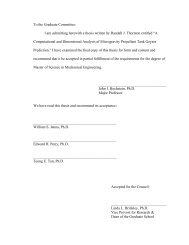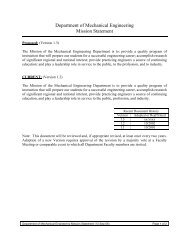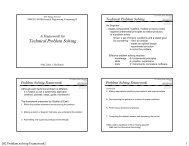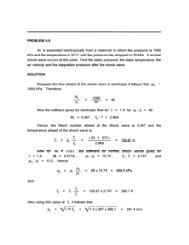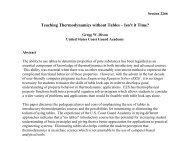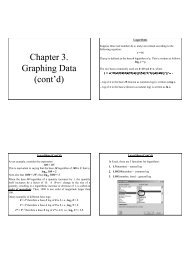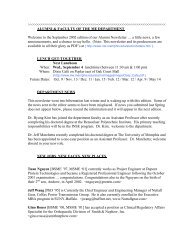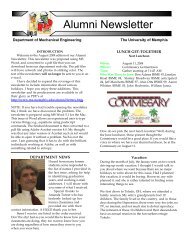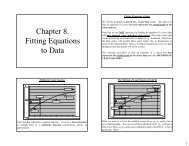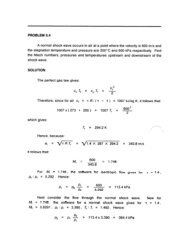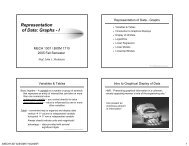MECHANICS of FLUIDS LABORATORY - Mechanical Engineering
MECHANICS of FLUIDS LABORATORY - Mechanical Engineering
MECHANICS of FLUIDS LABORATORY - Mechanical Engineering
You also want an ePaper? Increase the reach of your titles
YUMPU automatically turns print PDFs into web optimized ePapers that Google loves.
Experiment II<br />
For a number <strong>of</strong> wings, lift and drag data<br />
vary only slightly with Reynolds number and<br />
therefore if lift and drag coefficients are graphed<br />
as a function <strong>of</strong> Reynolds number, the results are<br />
not that meaningful. A more significant<br />
representation <strong>of</strong> the results is given in what is<br />
known as a polar diagram for the wing. A polar<br />
diagram is a graph on a linear grid <strong>of</strong> lift<br />
coefficient (vertical axis) as a function <strong>of</strong> drag<br />
coefficient. Each data point on the graph<br />
corresponds to a different angle <strong>of</strong> attack, all<br />
measured at one velocity (Reynolds number).<br />
Referring to Figure 11.2 (which is the<br />
experimental setup here), the angle <strong>of</strong> attack α is<br />
measured from a line parallel to the chord c to a<br />
line that is parallel to the free stream velocity.<br />
If so instructed, obtain lift force, drag force and<br />
angle <strong>of</strong> attack data using a pre selected velocity.<br />
Allow the angle <strong>of</strong> attack to vary from a negative<br />
angle to the stall point and beyond. Obtain data<br />
at no less than 9 angles <strong>of</strong> attack. Use the data to<br />
produce a polar diagram.<br />
Analysis<br />
Lift and drag data are usually expressed in<br />
dimensionless terms using lift coefficient and drag<br />
coefficient. The lift coefficient is defined as<br />
L f<br />
C L<br />
=<br />
ρV 2 A/2<br />
where L f is the lift force, ρ is the fluid density, V<br />
is the free stream velocity far upstream <strong>of</strong> the<br />
wing, and A is the area <strong>of</strong> the wing when seen<br />
from a top view perpendicular to the chord<br />
length c. The drag coefficient is defined as<br />
D f<br />
C D<br />
=<br />
ρV 2 A/2<br />
in which D f<br />
is the drag force.<br />
29



